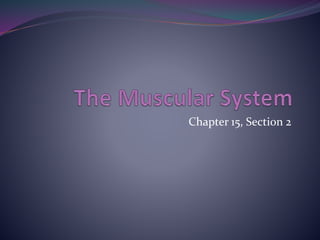The muscular system
•Als PPTX, PDF herunterladen•
0 gefällt mir•145 views
The Muscular System
Melden
Teilen
Melden
Teilen

Weitere ähnliche Inhalte
Was ist angesagt?
Was ist angesagt? (18)
Ähnlich wie The muscular system
Ähnlich wie The muscular system (20)
Mehr von jbrown9010
Mehr von jbrown9010 (20)
Kürzlich hochgeladen
Making communications land - Are they received and understood as intended? webinar
Thursday 2 May 2024
A joint webinar created by the APM Enabling Change and APM People Interest Networks, this is the third of our three part series on Making Communications Land.
presented by
Ian Cribbes, Director, IMC&T Ltd
@cribbesheet
The link to the write up page and resources of this webinar:
https://www.apm.org.uk/news/making-communications-land-are-they-received-and-understood-as-intended-webinar/
Content description:
How do we ensure that what we have communicated was received and understood as we intended and how do we course correct if it has not.Making communications land - Are they received and understood as intended? we...

Making communications land - Are they received and understood as intended? we...Association for Project Management
https://app.box.com/s/7hlvjxjalkrik7fb082xx3jk7xd7liz3TỔNG ÔN TẬP THI VÀO LỚP 10 MÔN TIẾNG ANH NĂM HỌC 2023 - 2024 CÓ ĐÁP ÁN (NGỮ Â...

TỔNG ÔN TẬP THI VÀO LỚP 10 MÔN TIẾNG ANH NĂM HỌC 2023 - 2024 CÓ ĐÁP ÁN (NGỮ Â...Nguyen Thanh Tu Collection
Kürzlich hochgeladen (20)
Kodo Millet PPT made by Ghanshyam bairwa college of Agriculture kumher bhara...

Kodo Millet PPT made by Ghanshyam bairwa college of Agriculture kumher bhara...
On National Teacher Day, meet the 2024-25 Kenan Fellows

On National Teacher Day, meet the 2024-25 Kenan Fellows
Seal of Good Local Governance (SGLG) 2024Final.pptx

Seal of Good Local Governance (SGLG) 2024Final.pptx
Making communications land - Are they received and understood as intended? we...

Making communications land - Are they received and understood as intended? we...
TỔNG ÔN TẬP THI VÀO LỚP 10 MÔN TIẾNG ANH NĂM HỌC 2023 - 2024 CÓ ĐÁP ÁN (NGỮ Â...

TỔNG ÔN TẬP THI VÀO LỚP 10 MÔN TIẾNG ANH NĂM HỌC 2023 - 2024 CÓ ĐÁP ÁN (NGỮ Â...
Micro-Scholarship, What it is, How can it help me.pdf

Micro-Scholarship, What it is, How can it help me.pdf
Food safety_Challenges food safety laboratories_.pdf

Food safety_Challenges food safety laboratories_.pdf
UGC NET Paper 1 Mathematical Reasoning & Aptitude.pdf

UGC NET Paper 1 Mathematical Reasoning & Aptitude.pdf
Python Notes for mca i year students osmania university.docx

Python Notes for mca i year students osmania university.docx
The muscular system
- 1. Chapter 15, Section 2
- 2. Movement In the process of moving, energy is used, work is done. More than 600 muscles in the body Some muscles in your body are always moving. Breathing Heart beating Digestive system working
- 3. Muscle control Voluntary muscles—muscles you are able to control Examples: face, hand ,arm Involuntary muscles—muscles that you can’t control Work all day long, all your life Pump blood through vessels and move food through digestive system
- 4. Classification of Muscle Tissue Skeletal muscle tissue Voluntary muscles that move bone More common than other muscle types Attached to bones by tendons Striated (appear striped under microscope)
- 5. Cardiac muscle tissue Found only in heart Striated Contracts about 70 times per minute all your life Smooth muscle tissue Non-striated Involuntary Found in bladder, intestines, blood vessels, other internal organs
- 6. Working Muscles You move because pairs of skeletal muscles work together. When one muscle of a pair of muscles contracts, the other muscle relaxes or returns to its original length. Muscles always pull; they never push
- 7. Changes in Muscles Over time, muscles become larger or smaller depending on whether or not they are used. Muscles that are given regular exercise respond quickly to stimuli. Some of the change in muscle size is because of an increase in the number of muscle cells.
- 8. However, most of the change in muscle size is because individual muscle cells become larger. Muscles that aren’t worked, become smaller in size.
- 9. How muscles move Muscles need energy to contract and relax. Your blood carries energy-rich molecules to your muscle cells, where chemical energy is released. As muscle contracts, this released energy changes to mechanical energy (movement) and thermal energy (heat).